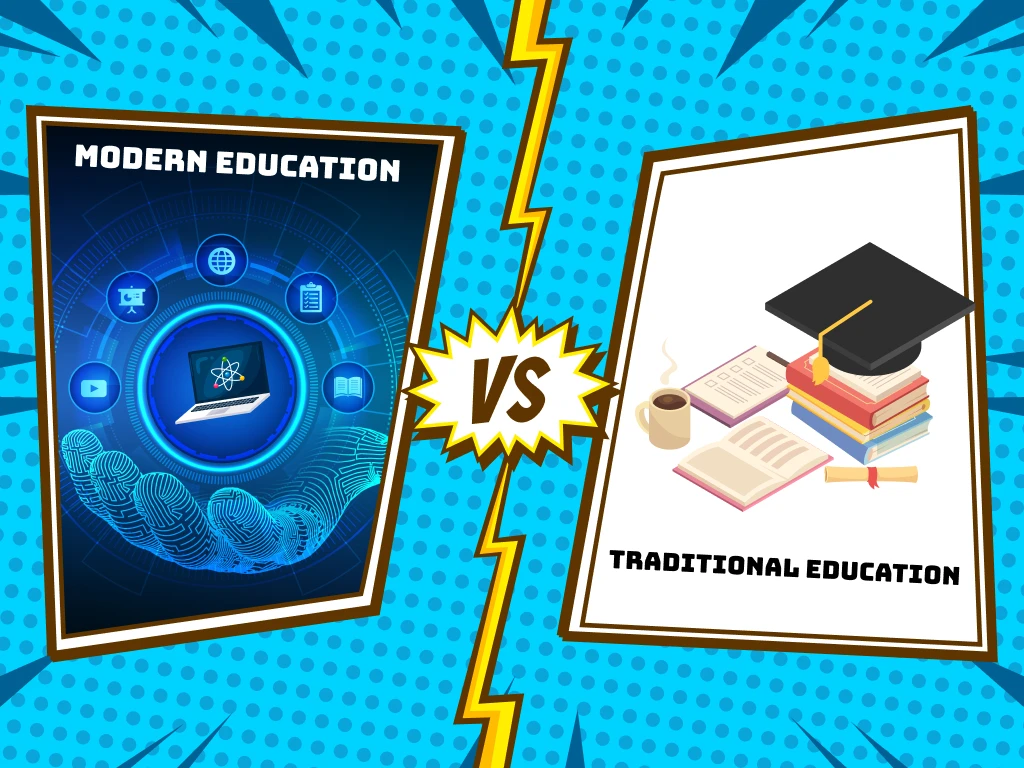Dear students, have you all noticed a shift from blackboard and chalk to screens and laptops? Education is the key weapon that can transform lives and create a bright future. It has evolved into various dimensions since the beginning. Our ancestors had a kind of education, and now it has taken a totally different dimension. There is a transformation from traditional education to modern education, a fundamental shift that has affected students in numerous ways. This blog explores the contrasts between traditional education and modern education.
Traditional Education:
Traditional education, also known as conventional education, leads a teacher-centred curriculum where the teachers pass on the knowledge they have acquired to the students. The system follows a structure, and students used to come to school where they sit together and learn with fellow students. This is a single-sided system where the information flows from the teacher to the student. Students practice discipline and follow a set of rules. Each school has its own standard and system. Students in this system of education were surrounded by textbooks, handwritten notes, lectures and regular routines.
Pros:
- Rigid structure & Routine:
This allows the student to follow a disciplined learning system. The student follows a consistent schedule and have a structured syllabus, which gives clarity on the lessons.
- No distractions:
This method increases the focus and concentration of the student by letting them learn one lesson at a time without wasting their time on social media.
- Guidance from the teacher:
The students receive guidance from the teacher on how to prepare a particular topic, and will gain a wide range of knowledge from the teacher.
Cons:
- Limited flexibility:
A student is supposed to learn everything at the scheduled time. The exams are conducted by the school. In this case, Flexibility is low when compared to modern education.
- No access to technological resources:
There is no access to technological resources in traditional education. The learning style involves rote memorisation, reciting spellings, mathematical tables, and handwritten essays.

Modern education:
Modern education is entirely different from traditional education. It replaced blackboards with glowing screens of mobile phones and laptops. It builds the essential skill sets in students and increases the creativity, critical thinking and problem-solving skills of the students. Meanwhile, it prepares them for the fast-changing world as it lets the students connect with various people. This method of education is not confined to a single room. It involves diverse techniques.
Pros:
- Global learning:
Modern learning gives access to global learning. Students can learn from schools and universities across the world. There is no geographical restriction in this learning, and they will get a chance to participate in various collaborative projects.
- Personalised learning:
Modern learning systems can be customised according to the person’s own time. The courses are mostly self-paced. The students can learn from home.
Cons:
- Screen fatigue:
Overuse of mobile screens and laptops may lead to screen fatigue, creating eye irritation and headaches.
- Unequal access:
Not all students can have access to modern education because internet connectivity is not the same in all areas. Students from rural areas experience poor network connectivity, and many children can’t afford a digital gadget, leading to the digital divide in the learning process.
Both modes of education are useful and fruitful if it is utilised and acquired properly. It depends on the mindset of the students; some students thrive in a structured environment, while others flourish in a flexible environment. Some may blend into both environments. Education can benefit you in any way, so choosing the right path will make you an intellectual person. What do you think? Do you prefer the traditional classroom or the modern one?
